
No question, this may have been the most “fun” cake I’ve ever made. And it’s really very easy to boot. It’s not like you might have trouble getting your family (kids, especially) to eat cake, but this one they might enjoy more than usual.
Really, this is nothing but a vanilla cake, divided in half with dark cocoa added to one half, then you carefully scoop small portions of each batter on top of each other until you’ve used up all the batters. It’s a type of marble cake, I suppose, it’s just that you treat the batter differently in the pan. A caution – don’t jiggle the pan much, don’t tilt it, and the recipe said definitely not to open the oven to check on it (at least for the first 20 minutes). All the hard zebra work occurs in the oven as the circles of batter rise and weave a bit. The cake batter came together very easily. I weighed the mixture to try to divide it equally – I came up with 880 grams total, so 440 in each bowl.
I sprayed the two small dippers I used with canola spray (although I really can’t say it helped after the first couple of scoops). You do need to be careful about drips – from whatever you’re using as your 2-3 T. dippers, as you do not want to see plops of batter all over the top of the cake. I tried my best to pour smoothly, but I wasn’t exact with mine, so some of the circles are a little wavy. Likely it doesn’t make any difference to the finished product. You scoop vanilla in first. It spreads a little bit – flattens out, but it’s thick enough that it doesn’t go very far. Then you scoop chocolate batter, in the CENTER of the vanilla, then vanilla in the middle of the chocolate, and so on. Eventually the first scoop has pushed itself all the way to the outside edges, with all the other stripes right behind it. I ended up with a bit more chocolate leftover, so the last scoop ended up being about two. If you want more defined separations, you may want to use about 3 T. of batter per pour.
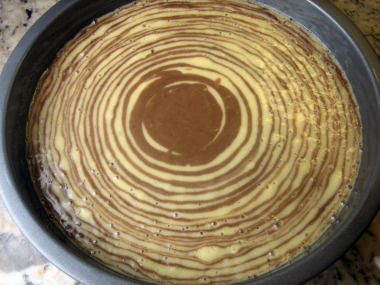 Here’s a photo of the batter before baking. Fun, huh? This recipe is in several places on the internet, I found, with a few variations (one mixture has Sprite in it). The recipe I used came from Ferida at AZCookbook, a blogger who hails from Azerbijan. She lives not too far from me, actually, in Long Beach, California. Ferida’s recipe called for 3 T. of batter for each stripe, but others I read suggested 2 T, so I decided to try that. The only other caution I read in several places is that you need to use DARK cocoa (you can use Hershey’s, though it’s more bitter than some and will make a less-sweet cake), and not Dutch process (too light/mild). My extra dark cocoa came from Penzey’s, in case you want to try it. It wasn’t as dark as I might have liked to see, comparing my cake with the photos of others’.
Here’s a photo of the batter before baking. Fun, huh? This recipe is in several places on the internet, I found, with a few variations (one mixture has Sprite in it). The recipe I used came from Ferida at AZCookbook, a blogger who hails from Azerbijan. She lives not too far from me, actually, in Long Beach, California. Ferida’s recipe called for 3 T. of batter for each stripe, but others I read suggested 2 T, so I decided to try that. The only other caution I read in several places is that you need to use DARK cocoa (you can use Hershey’s, though it’s more bitter than some and will make a less-sweet cake), and not Dutch process (too light/mild). My extra dark cocoa came from Penzey’s, in case you want to try it. It wasn’t as dark as I might have liked to see, comparing my cake with the photos of others’.
The cake itself? Very nice. With a cup of oil in it, it’s certainly not “light!” But it’s good. I made the cake after dinner the other night and it was lovely in the morning for Dave’s Bible Study group. Next time I probably will use Ferida’s suggestion of 3 T. per pour, and that’s about the only thing I’d change. Maybe I’ll try Hershey’s cocoa just to see the difference. I used a nonstick pan, and did grease it with oil, but I had a bit of difficulty getting the cake out, so I’d recommend you use parchment paper on the bottom even if you’re using a nonstick pan.
printer-friendly PDF
Zebra Cake
Recipe: From azcookbook.com (blog)
Servings: 10
4 large eggs — at room temperature
1 cup granulated sugar — (8 oz / 250 g)
1 cup milk — (8 fl oz / 250 ml) at room temperature
1 cup oil — (8 fl oz / 250 ml) vegetable or canola is fine
2 cups all-purpose flour — (10 oz / 300 g)
1/3 teaspoon vanilla powder
1 tablespoon baking powder — or substitute 1 teaspoon baking soda
2 tablespoons dark cocoa powder — (not Dutch-processed)
1. In a large mixing bowl, combine eggs and sugar. Using a hand-held electric mixer or wire whisk beat until the mixture is creamy and light in color
2. Add milk and oil, and continue beating until well blended.
3. In a separate bowl, combine and mix flour, vanilla powder and baking powder. Gradually add the flour mixture to the wet ingredients and beat just until the batter is smooth and the dry ingredients are thoroughly incorporated. DO NOT OVERBEAT – air pockets may form.
4. Divide the mixture into 2 equal portions. Keep one portion plain. Add cocoa powder into another and mix well.
5. Preheat the oven to 350 (180C).
6. Lightly grease the pan with oil. If you don’t have non-stick baking pan, grease whatever pan you have and line with parchment paper.
7. Scoop 3 heaped tablespoons of plain batter (you can also use a ladle that would hold 3 tablespoons) into the middle of the baking pan. Then scoop 3 tablespoons of cocoa batter and pour it in the center on top of the plain batter. IMPORTANT! Do not stop and wait until the previous batter spreads – KEEP GOING! Do not spread the batter or tilt the pan to distribute the mixture. It will spread by itself and fill the pan gradually. Continue alternating the batters until you finish them.
8. Bake in the oven for about 40 minutes. Do not open the oven door at least the first 20 minutes or the cake will shrink and will not rise. A toothpick inserted into the center should come out clean. Remove from the oven. Immediately run a small thin knife around the inside of the pan to loosen the cake, then invert the cake onto a cooking rack. Turn the cake back over and let cool. You can sprinkle the top of the cake with some powdered sugar or leave it plain.
Per Serving: 409 Calories; 25g Fat (54.3% calories from fat); 6g Protein; 41g Carbohydrate; 1g Dietary Fiber; 88mg Cholesterol; 187mg Sodium.
A year ago: A Master Grilling Guide (what temp to grill meats)




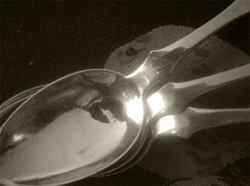

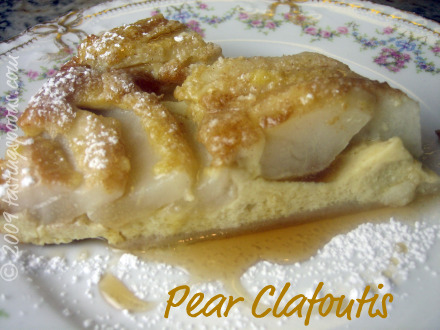
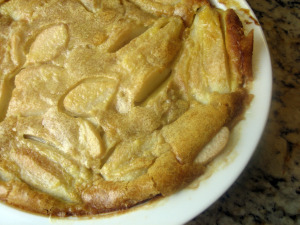 If you’ve never made a clafoutis (I think it’s pronounced cla-foo-tee), it’s really very, VERY easy. It doesn’t exactly make a pastry bottom, but sort of. You whisk up a thin batter of eggs, sugar (I used Splenda so my husband could have some), melted butter, a bit of flour, flavorings (cinnamon, vanilla and maple) and some milk. The fruit is sliced up into the bottom of a buttered tart, pie or cake pan, preferably in a decorative pattern, then the batter is poured on top. The egg custardy batter settles down in between the fruit and bakes nicely in the oven for nearly an hour. If you glance at the top picture you can see the custardy mixture that creates a sort-of eggy pastry on the bottom.
If you’ve never made a clafoutis (I think it’s pronounced cla-foo-tee), it’s really very, VERY easy. It doesn’t exactly make a pastry bottom, but sort of. You whisk up a thin batter of eggs, sugar (I used Splenda so my husband could have some), melted butter, a bit of flour, flavorings (cinnamon, vanilla and maple) and some milk. The fruit is sliced up into the bottom of a buttered tart, pie or cake pan, preferably in a decorative pattern, then the batter is poured on top. The egg custardy batter settles down in between the fruit and bakes nicely in the oven for nearly an hour. If you glance at the top picture you can see the custardy mixture that creates a sort-of eggy pastry on the bottom.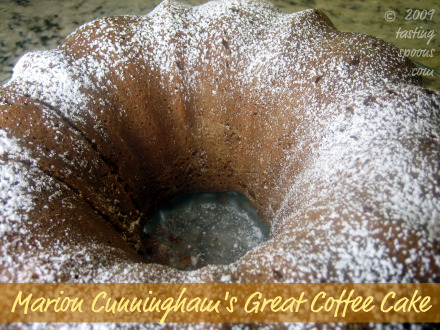
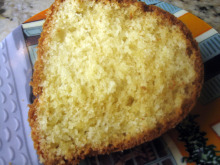 The recipe also included a number of variations (raisin and spice, dried fig and almond, apple and walnut, and vanilla). Those are in the PDF recipe you will get if you print it out from the link at the bottom. But for the first time around I wanted to make this true to the original. The coffee cake was plain. Good kind of plain. A very tender crumb. Next time I make this I’ll try one of the variations.
The recipe also included a number of variations (raisin and spice, dried fig and almond, apple and walnut, and vanilla). Those are in the PDF recipe you will get if you print it out from the link at the bottom. But for the first time around I wanted to make this true to the original. The coffee cake was plain. Good kind of plain. A very tender crumb. Next time I make this I’ll try one of the variations.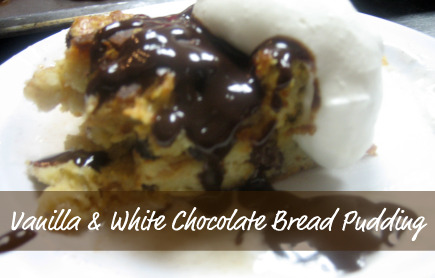
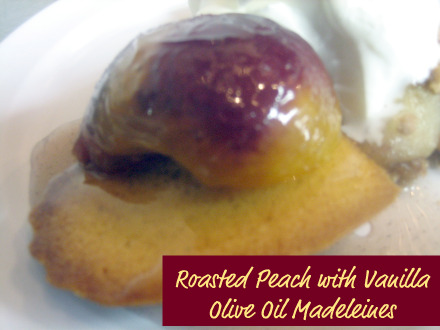
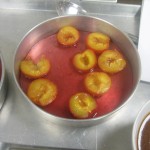 The recipe here was from the vanilla class I attended last week. The chef thought it came from a Nancy Silverton cookbook. I couldn’t find it online, nor anything close to it, so I couldn’t verify its origin. Nevertheless, it’s a very nice use of either peaches or plums (or apricots, for that matter, but they’re such a tender fruit I’m not sure they’d hold up). The fruit is roasted in a sugar-vanilla-chamomile syrup until tender and golden. This time of year we used imported peaches from the Southern Hemisphere. Meanwhile, you make a cookie dough using olive oil, and bake them in tartlet molds (big enough to hold the fruit), or in Madeleine pans, coated lightly with additional olive oil. Unfortunately, at the class, the instructor had forgotten to get the chamomile for the syrup, so we ate it without. I’d try it with, however, since it sounds like such a gentle combination.
The recipe here was from the vanilla class I attended last week. The chef thought it came from a Nancy Silverton cookbook. I couldn’t find it online, nor anything close to it, so I couldn’t verify its origin. Nevertheless, it’s a very nice use of either peaches or plums (or apricots, for that matter, but they’re such a tender fruit I’m not sure they’d hold up). The fruit is roasted in a sugar-vanilla-chamomile syrup until tender and golden. This time of year we used imported peaches from the Southern Hemisphere. Meanwhile, you make a cookie dough using olive oil, and bake them in tartlet molds (big enough to hold the fruit), or in Madeleine pans, coated lightly with additional olive oil. Unfortunately, at the class, the instructor had forgotten to get the chamomile for the syrup, so we ate it without. I’d try it with, however, since it sounds like such a gentle combination.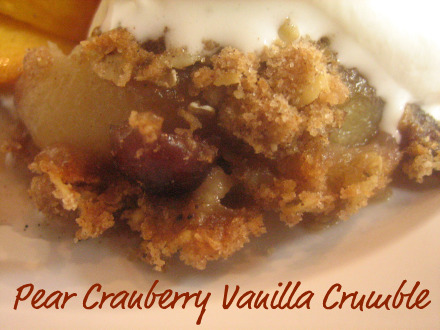
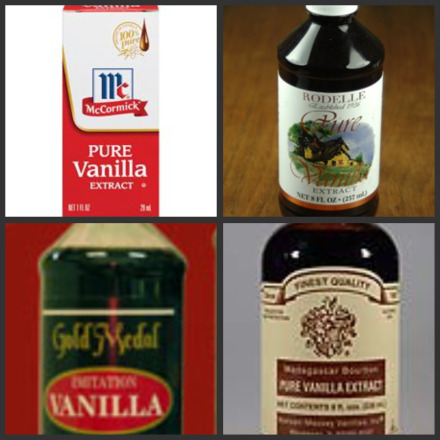

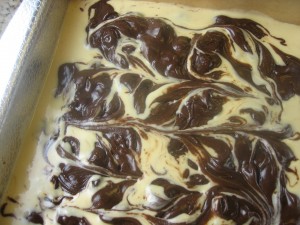




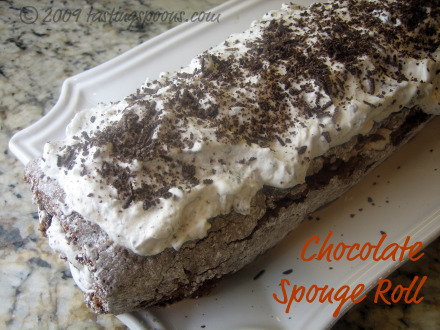
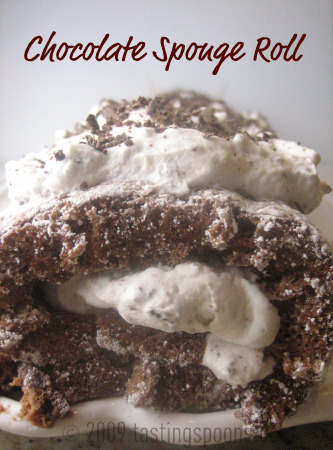 The only tough part about this dessert is rolling, unrolling and filling, then rolling up the cake. I’ve rarely made it when it didn’t crack somewhere. I never seem to know the exact time to unroll and fill this. But, even with the cracks, you just do the best you can, and trust me, nobody will care once they taste it. When you roll it up, put the break on the underside, if possible. You can actually see a break in mine (in the photo at the top) – along the front right. Did it affect anything? Not at all.
The only tough part about this dessert is rolling, unrolling and filling, then rolling up the cake. I’ve rarely made it when it didn’t crack somewhere. I never seem to know the exact time to unroll and fill this. But, even with the cracks, you just do the best you can, and trust me, nobody will care once they taste it. When you roll it up, put the break on the underside, if possible. You can actually see a break in mine (in the photo at the top) – along the front right. Did it affect anything? Not at all.
Leave a Comment!